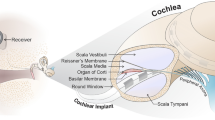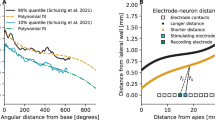Abstract
Electrical stimulation of the brain has resulted in the most successful neuroprosthetic techniques to date: deep brain stimulation (DBS) and cochlear implants (CI). In both cases, there is a lack of pre-operative measures to predict the outcomes after implantation. We argue that highly detailed computational models that are specifically tailored for a patient can provide useful information to improve the precision of the nervous system electrode interface. We apply our framework to the case of CI, showing how we can predict nerve response for patients with both intact and degenerated nerve fibers. Then, using the predicted response, we calculate a metric for the usefulness of the stimulation protocol and use this information to rerun the simulations with better parameters.








Similar content being viewed by others
References
Rodriguez-Oroz M, Obeso J, Lang A, Houeto JL, Pollak P, Rehncrona S, Kulisevsky J, Albanese A et al (2005) Bilateral deep brain stimulation in Parkinson’s disease: a multicentre study with 4 years follow-up. Brain 128(10):2240–2249
Wilson BS, Dorman MF (2008) Cochlear implants: a remarkable past and a brilliant future. Hear Res 242(1):3–21
McIntyre CC, Savasta M, Walter BL, Vitek JL (2004) How does deep brain stimulation work? Present understanding and future questions. J Clin Neurophysiol 21(1):40–50
Boyd PJ (2011) Potential benefits from deeply inserted cochlear implant electrodes. Ear Hear 32(4):411–427
Maks CB, Butson CR, Walter BL, Vitek JL, McIntyre CC (2009) Deep brain stimulation activation volumes and their association with neurophysiological mapping and therapeutic outcomes. J Neurol Neurosurg Psychiatry 80(6):659–666
Malherbe TK, Hanekom T, Hanekom JJ (2013) Can subject-specific single-fibre electrically evoked auditory brainstem response data be predicted from a model? Med Eng Phys 35(7):926–936
Yushkevich PA, Piven J, Hazlett HC, Smith RG, Ho S, Gee JC, Gerig G (2006) User-guided 3D active contour segmentation of anatomical structures: significantly improved efficiency and reliability. Neuroimage 31(3):1116–1128
Lorensen WE, Cline HE (1987) Marching cubes: a high resolution 3D surface construction algorithm. In: ACM Siggraph Computer Graphics, ACM, vol 21, pp 163–169
Paulsen RR, Baerentzen JA, Larsen R (2010) Markov random field surface reconstruction. Vis Comput Graph IEEE Trans 16(4):636–646
Ruokolainen J, Lyly M (2000) ELMER, a computational tool for PDEs—application to Vibroacoustics. CSC News 12(4):30–32
Råback P, Malinen M, Ruokolainen J, Pursula A, Zwinger T (2013) Elmer models manual. CSC–IT Center for Science, Helsinki
Saba R (2012) Cochlear implant modelling: stimulation and power consumption. URL http://eprints.soton.ac.uk/348818/
Frijns JHM, De Snoo S, Schoonhoven R (1995) Potential distributions and neural excitation patterns in a rotationally symmetric model of the electrically stimulated cochlea. Hear Res 87(1):170–186
Briaire JJ, Frijns JH (2006) The consequences of neural degeneration regarding optimal cochlear implant position in scala tympani: a model approach. Hear Res 214(1):17–27
Jones E, Oliphant T, Peterson P et al (2001) SciPy: open source scientific tools for Python. URL http://www.scipy.org/
Vanpoucke FJ, Boermans P, Frijns JH (2012) Assessing the placement of a cochlear electrode array by multidimensional scaling. Biomed Eng IEEE Trans 59(2):307–310
Gani M, Valentini G, Sigrist A, Kós MI, Boëx C (2007) Implications of deep electrode insertion on cochlear implant fitting. J Assoc Res Otolaryngol 8(1):69–83
Stakhovskaya O, Sridhar D, Bonham BH, Leake PA (2007) Frequency map for the human cochlear spiral ganglion: implications for cochlear implants. J Assoc Res Otolaryngol 8(2):220–233
Mistrík P, Mullaley C, Mammano F, Ashmore J (2009) Three-dimensional current flow in a large-scale model of the cochlea and the mechanism of amplification of sound. J R Soc Interface 6(32):279–291
Acknowledgments
The research leading to these results received funding from the European Union Seventh Frame Programme (FP7/2007-2013) under grant agreement 304857.
Author information
Authors and Affiliations
Corresponding author
Rights and permissions
About this article
Cite this article
Ceresa, M., Mangado, N., Andrews, R.J. et al. Computational Models for Predicting Outcomes of Neuroprosthesis Implantation: the Case of Cochlear Implants. Mol Neurobiol 52, 934–941 (2015). https://doi.org/10.1007/s12035-015-9257-4
Received:
Published:
Issue Date:
DOI: https://doi.org/10.1007/s12035-015-9257-4




